
When we evaluate firearms, there are guidelines we follow. Some of the projects are a result of market forces, where we are guided by what is new in the market place. Then there are reader requests. The following evaluation combines those arenas. Readers have shown interest in the M1 30 Carbine because it is a lightweight, handy rifle with historical overtones that shooters of a certain age respect. Accordingly, we have done comparisons of the rifles head to head and also ammunition testing.
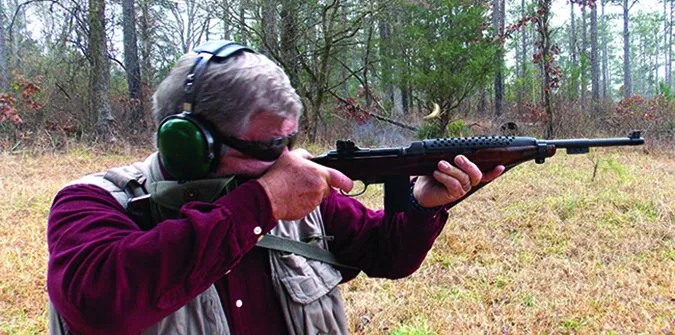
Likewise, we have extensively tested AR-15 rifles and ammunition. So, coupled with experience in handling both rifles and the preference of some of the raters, we cooked up an AR-15 versus M1 Carbine shoot-out, with a slant toward inexpensive rifles for home defense. The M1 Carbine is fairly inexpensive in most examples, including good-quality modern reproductions such as the Auto Ordnance. Until very recently when regulatory bans began pointing anew at the semi-auto rifle, the AR-15 had been increasingly affordable, and we even saw something of a price war going on as late as January 2018. So, with a budget theme in mind, we chose two rifles for a new shooter on a budget and limited the spend to $800, including a reasonable number of magazines and a credible ammunition supply. Counted in this evaluation were the opinions of inexperienced and female shooters, the latter of which we listened to carefully to find a combination of recoil, muzzle blast, and firearm weight the distaff gun owner might prefer.

Some prefer a long gun for home defense for its power and accuracy, and the fact that handguns require time and inclination to master, a rifle can be an easier-to-learn tool, especially if area defense is also a consideration — that is, your yard is pretty large or if roaming predators, such as coyotes and feral dogs, are a consideration. A hard-hitting but light-kicking rifle can give results much beyond what a handgun can do for most shooters, if the rifle is reliable and accurate enough.
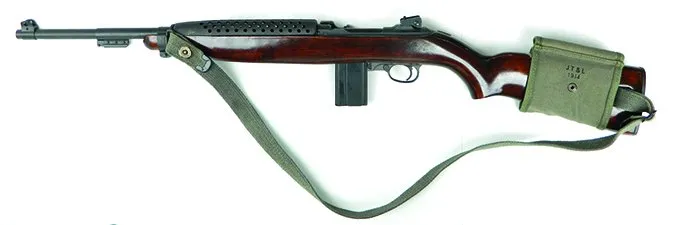
The ammunition testing we have previously done in each caliber is an important part of the summary of facts in this feature. In terms of power, the 30 Carbine round in its most-common size, 110 grains, runs slightly behind the standard 223 Remington in a 55-grain bullet. But power isn’t the only consideration for someone using a rifle inside a home. Too much penetration is a problem. Choosing the right round is crucial to balance what’s needed to stop the fight and what’s too much. In previous tests, we found the Hornady 110-grain Critical Defense 30 Carbine round produced 1980 fps and the resulting energy of 957 foot-pounds. Shot into water, that round terminated with an expanded width of 0.47 inch and weight retention of 100%. It penetrated 20 inches of water. A Hornady V-Max 223 Remington load with a 55-grain bullet sped along at 2890 fps and produced muzzle energy of 1019 foot-pounds. That might worry the home defender, but this particular round finished with an expanded width of 0.44 inches of the largest fragment. It retained 50% of its weight and only penetrated 10 inches in water. The AR, again, has the edge because it’s possible to tailor the load to the home, and that’s not as feasible with the 30 Carbine rounds.
M1 30 Carbine Range Data
| Federal Power-Shok 30 Carbine 110-gr. Soft-Point Round Nose 30CA | |
| Average velocity | 1978 fps |
| Muzzle energy | 955 ft.-lbs. |
| Smallest group | 2 in. |
| Largest group | 2.8 in. |
| Average group | 2.5 in. |
| Hornady Critical Defense 30 Carbine 110-gr. FTX 81030 | |
| Average velocity | 1980 fps |
| Muzzle energy | 957 ft.-lbs. |
| Smallest group | 2.4 in. |
| Largest group | 3.2 in. |
| Average group | 2.8 in. |
AR-15 Self-Build Range Data
| Hornady Zombie Max 223 Rem. AR-15 55-gr. V-Max 83271 |
|
| Average velocity | 2890 fps |
| Muzzle energy | 1019 ft.-lbs. |
| Smallest group | 0.75 in. |
| Largest group | 1.5 in. |
| Average group | 1.2 in. |
| Federal American Eagle 223 Rem.55-gr. FMJ AE223J | |
| Average velocity | 2960 fps |
| Muzzle energy | 1069 ft.-lbs. |
| Smallest group | 0.9 in. |
| Largest group | 1.8 in. |
| Average group | 1.3 in. |
To collect accuracy data at 50 yards, we fired five-shot groups from a bench rest. We recorded velocities with a Shooting Chrony Master Chronograph.
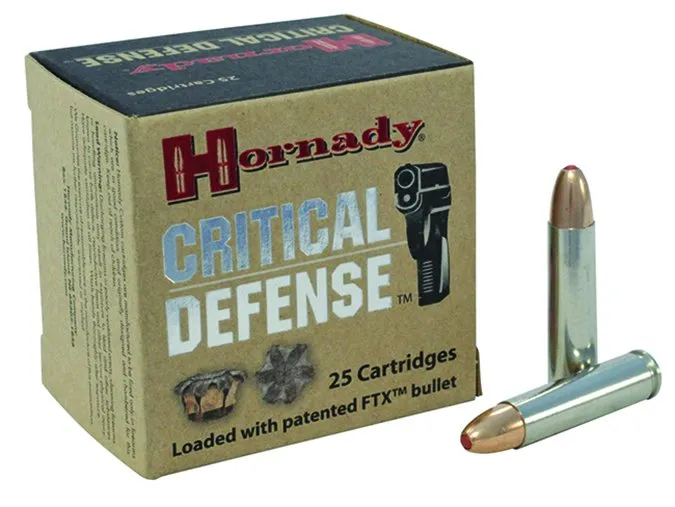
Ammo sources: 30 Carbine 110-gr. Federal Power-Shok Soft-Point Round Nose 30CA ($29.44/50 from SportsmansGuide.com); 30 Carbine Hornady Critical Defense 110-grain FTX 81030 ($21.27/25 rounds from SportsmansGuide.com); 223 Remington Hornady Zombie 55-grain Max V-Max 83271 ($25.18/25 from SportsmansGuide.com); Federal American Eagle 55-gr. AE223J ($37/100 from SportsmansGuide.com).
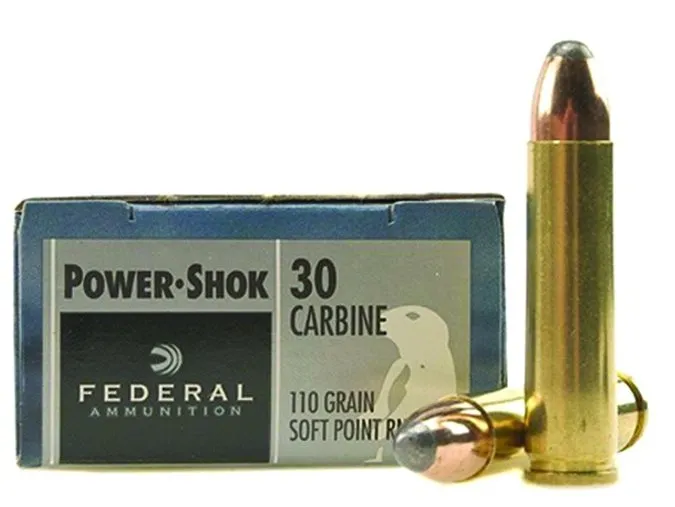
How do these rifle rounds stack up to some common handgun loads? They’re much more powerful. As noted above, the 30 Carbine Hornady FXT generates muzzle energy of 957 foot-pounds and the 223 Hornady V-Max 1019 foot-pounds. In comparison, a Double Tap 10mm 135-grain round generates 1555 fps and 725 foot-pounds of energy. A Black Hills 357 Magnum 125-grain round running 1430 fps makes 567 foot-pounds of muzzle energy, and a Black Hills 45 ACP 230-grain JHP clicking along at 850 fps makes a paltry 369 foot-pounds of muzzle energy.
So with those facts in mind, we compared an Israeli Arms International M1 30 Carbine and a home-built AR-15. Average price at GunBroker.com and other outlets was $480 for the 30 Carbine. Also, we found a Universal Carbine in a local shop for $425, and average price for a new Auto Ordnance 30 carbine was $775. We found a new Del-Ton AR-15 at SCGunCo.com for $399 new in the shop. There are many good AR-15 rifles going begging at the beginning of the year for $600 and less. This is a turnaround from a year ago. So, a clear winner on the price scale goes to a budget AR, at least until a new buying boom changes that. For more stable pricing, we chose to test a gun we built ourselves, mainly using parts from Brownells.com. The test AR-15 rifle consists of an Aero upper and receiver, Brownells barrel, and Brownells bolt. The parts priced out to $600, and we got what we consider to be an average rifle with good components. We realize you can go as high as you want on the AR-15 and spend several thousand dollars, but that isn’t what we are doing in this report.

When it comes to ammunition supply, the 5.56mm/223 Remington is the hands-down winner as far as quantity. There are many choices. At the SportsmansGuide.com, Federal American Eagle 30 Carbine JSP ammunition used in the test was $29.44 for fifty rounds. Hornady’s Critical Defense 30 Carbine FTX is $21.27 from the same source for 25 rounds. When we shot this test, Federal Power-Shok 223 Remington FMJs were $50.39 for 100 rounds, or $25.18 or so for 50. That price has dropped to around $35 for the 100-round quantity for many full-jacket bullets. Hornady Zombie Match was $17.63 for 20 rounds, from the same source. It’s clear that 5.56/223 ammunition is not only less expensive, it is much more widely distributed. Chances are every little shack and large outlet will have the 223, which is not so for 30 Carbine in our canvas of local and some online shops. And those who stock 30 Carbine often have FMJs only and no jacketed soft-point loads. For home defense, the 30 Carbine is more than adequate based on terminal ballistics, but the choices are limited.
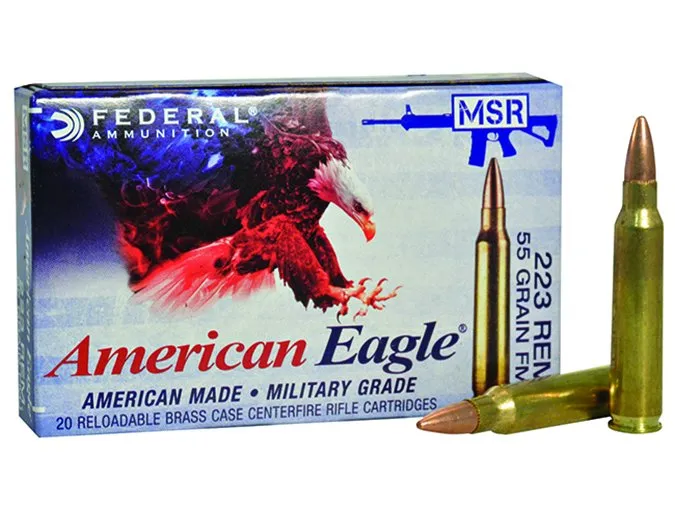
Additional kit is another consideration. We found 15-round magazines for the M1 Carbine at Brownells.com for $30 each. The 30-round AR Magpul PMag cost us $17.05 from Brownells.com. A good performer in our previous AR-15 magazine testing, the PMag works well. Magazines are not accessories, and the more the better, so pricing is a consideration there as well. Four is a minimum. So, we paid $120 plus shipping for four 30 Carbine magazines versus $68.20 for four AR-15 magazines. The AR wins again. We tried a half-dozen shops locally, and there were no magazines in stock for the 30 Carbine. When asked for AR-15 magazines, all the shopkeepers said, “Please come in, we have plenty.” And on top, our home-brew AR was optics ready, so mounting a red-dot sight was a matter of turning a couple of screws. On the M1, we would need to buy something like an Ultimak forward-handguard mount for the 30 Carbine, which Brownells.com had for $100. Also, mounting a combat light isn’t practical with the carbine. So, looking at just the set-up ease and costs, the M1 Carbine comes up short before we even begin shooting. We did not figure in the versatility of custom stocks and handguards for the AR-15 because we are on a budget. The rifle was fine as it was.
Israeli Arms International 30 Carbine, $480
GUN TESTS GRADE: A
The M1 Carbine was the original Personal Defense Weapon. Light, reliable, accurate enough for combat use to 200 yards, and hitting harder than a handgun, the 30 Carbine performed beyond expectation. The rifle in this test proved reliable and should give any homeowner real confidence for home defense.

| ACTION TYPE | Semi-automatic |
| OVERALL LENGTH | 35.75 in. |
| BARREL | 18 in. long; Parkerized steel |
| OVERALL HEIGHT | 6.9 in. |
| STOCK LENGTH OF PULL | 13.2 in. |
| WEIGHT UNLOADED | 5.2 lbs. |
| WEIGHT LOADED | 5.8 lbs. |
| MAGAZINE CAPACITY | 15/30, detachable box |
| ACTION | Parkerized steel |
| STOCK | Wood |
| TRIGGER PULL WEIGHT | 6.5 lbs. |
| FRONT SIGHT | Post |
| REAR SIGHT | Elevation-and-windage-adjustable aperture |
| SAFETY | Lever |
| WARRANTY | None |
| TELEPHONE | None |
| WEBSITE | None |
| MADE IN | USA |
The Israeli Arms carbine is out of production, but there are quite a few available in the used market, like our sample. The price listed is the average of several we found for sale online. In construction, it is similar or identical to modern 30 Carbine M1 replicas and late World War II production. The rifle is well made with good fit. The controls are crisp. The trigger breaks at 6.5 pounds with a sharp reset.
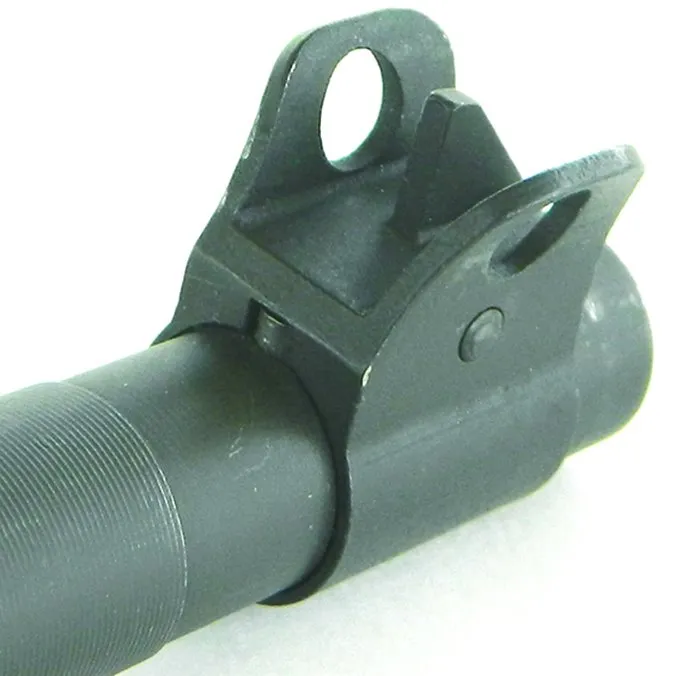
Manipulation is easy. The magazine is angled into the magazine well and locked in place. The bolt is racked to load the chamber. Alternately, there is a plunger on the cocking handle that may be used to lock the bolt to the rear. The bolt may then be released to run forward and load the carbine. The bolt locks open on the last shot. The lever-type safety works well and isn’t difficult to move to Fire. It is considered an improvement over the early push-button AR-15 safety. The military felt that the push-button safety was sometimes confused with the magazine release and made the change.
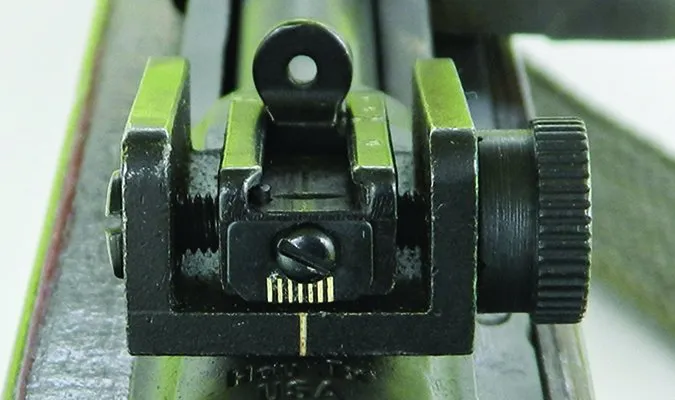
The rifle has a good natural point, and the balance and handling are good. The semi pistol grip allows good hand fit, and the forward hand position is comfortable on the wood stock. It is quite easy to rack the bolt without changing the firing position. The aperture sight is placed much lower on the bore line of the rifle than the AR-15. The rear aperture is an excellent all-round combat sight. The front post is easy to pick up quickly. This sighting arrangement is one of the advantages of the 30 Carbine over the AR-15. At home-defense ranges, the M1 may be regulated to fire to the point of aim. During close-range firing, the 30 Carbine was dead on the money with sight regulation using a 6 o’clock hold. At longer ranges, a dead-on hold could be used. Firing at 5, 7, and 10 yards, it was possible to quickly double tap or even stitch targets quickly. Fast follow-up shots are easy. An entire magazine could be emptied into the X-ring. Even relatively inexperienced shooters came up to speed quickly on this rifle. Fired offhand standing at 25 yards, the results were not much different than at 15 yards. Predators could be dusted off with this rifle in good order. There were no malfunctions with 50 rounds of American Eagle JSP loads or later with the Hornady Critical Defense loading.
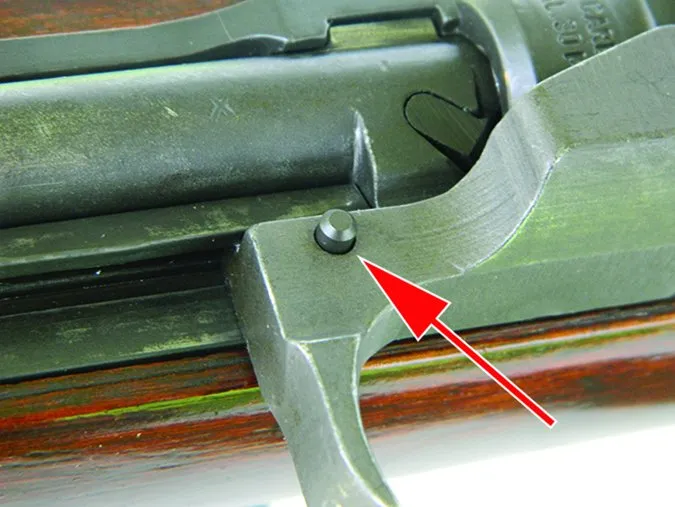
The 30-caliber carbine was fired primarily with the American Eagle 30-caliber load and also the Hornady FTX load for accuracy. At 25 yards, we shot groups of 0.75 to 1.25 inches from a benchrest firing position. At 50 yards, the rifle produced several 2-inch groups.
Our Team Said: This is an accurate and reliable rifle. It would work well for home defense based on its fast handling, light weight, and excellent terminal performance. Energy and terminal ballistics outstrip the 357 Magnum in a handgun, a proven performer, so there are no worries there. In firing more than 100 cartridges, and checking our records about another 200 or more fired in previous ammunition testing with the same rifle, there were no malfunctions of any type with personal-defense loads. We did experience short cycles with one brand of ammunition that was loaded to less than full-power standard during a ballistic evaluation.
AR-15 Aero Precision Receiver/Brownells Parts Build 5.56mm/223 Remington, $600
GUN TESTS GRADE: A (OUR PICK)
This rifle, assembled by an experienced builder, proved reliable, accurate, and capable in home defense. The good quality of the parts and the capable handling of the AR-15 rifle made it a first choice for all-round defense. The system is superior to the M1 30 Carbine, in our estimation.
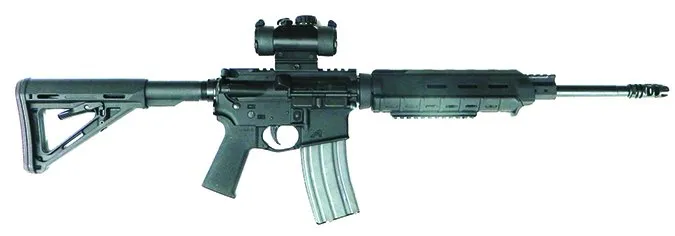
| ACTION TYPE | Gas-operated semi-automatic |
| OVERALL LENGTH | 32 to 35.75 in. |
| BARREL LENGTH | 16 in. |
| OVERALL HEIGHT | 11.5 in. w/ TruGlo 30mm Red Dot and 30-rd. mag |
| STOCK LENGTH OF PULL | 10 to 14.25 in., adjustable |
| WEIGHT UNLOADED | 6.8 lbs. |
| WEIGHT LOADED | 7.55 lbs. |
| MAGAZINE | 20/30 rounds, detachable box |
| ACTION | Black anodized aluminum alloy |
| BARREL | Black Parkerized steel |
| TRIGGER PULL WEIGHT | 3.25 lbs. |
| SAFETY | 2-pos. switch |
| FRONT SIGHT | Elevation-adjustable post |
| REAR SIGHT | Elevation- and windage-adjustable apertures |
| WARRANTY | Only individual parts |
| TELEPHONE | (641) 623-5401 |
This rifle came off the build-bench shooting without any type of malfunction and had been fired extensively by the owner prior to this shoot-out. The 30 Carbine had also been fired extensively, so both had plenty of break-in time. The AR-15 build proved easy to maneuver quickly. As for rapidly cocking the piece when held in the firing position, we found that all the shooter needed to do was turn the head to one side to accommodate the movement. The pistol grip allowed excellent control in tight quarters. The MOE handguard felt good in the hand, and with the proper technique, the rifle is fast to get on target. While we fired the M1 Carbine first and were impressed, a side-by-side shoot-out like this reinforces the good qualities of the AR-15. As an example, one rater fired the M1 carbine with one hand, bringing the sights to the eye and simulating an injury in the support hand or firing in very tight quarters.
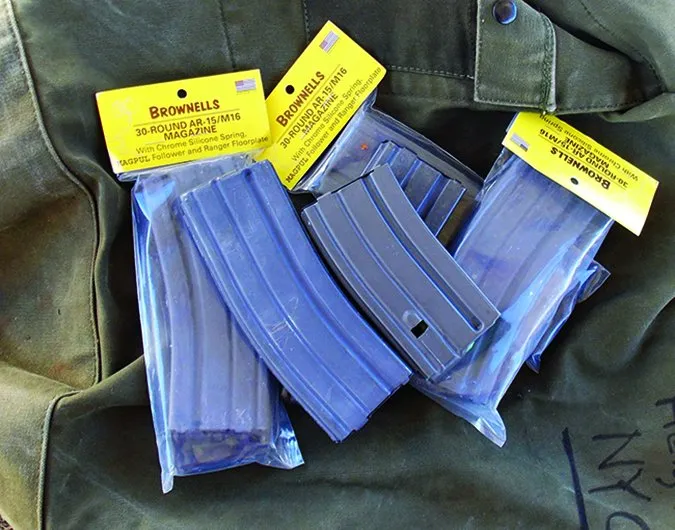
The 30 Carbine was easy to heft and fire. Surprisingly, the AR-15 was almost as easy — only a muscle tremor intruded toward the end of firing a magazine. As for accuracy with either 223 load listed in the Range Data table, the rifle was controllable and accurate. Fast groups on target were excellent to 25 yards. The 30 Carbine fared better for most due to sight regulation out to 10 yards, but outside this range, the AR-15 proved superior. As for accuracy, the AR-15 rifle turned in several 0.7- to 1.0-inch groups at 25 yards, with groups of 0.75 to 1.5 inches at 50 yards with the TruGlo red dot mounted. The sole drawback of the rifle for home defense is the sight offset. This resulted in the bullet going 4.5 inches low at 7 yards. The 30 Carbine was easily sighted in for 7 yards using a 6 o’clock hold with the provided iron sights. During the AR portion, we used Leapers fixed sights. However, because we had room under our budget, we fitted a TruGlo 30mm Red Dot ($58 from CheaperThanDirt.com). After a thorough evaluation, we find the TruGlo to be a good buy for the money, and it helped us get hits at close range.
As we noted, we fired the two rifles at combat distances of 5, 10, and 15 yards, much the same as handgun evaluations. However, we also added a drill in which we engaged two threats quickly at 15 yards to test viability against gangs. We tried to simulate a crowded hallway. At close range, inside of 15 yards, the M1 carbine handled more quickly, our shooters said.
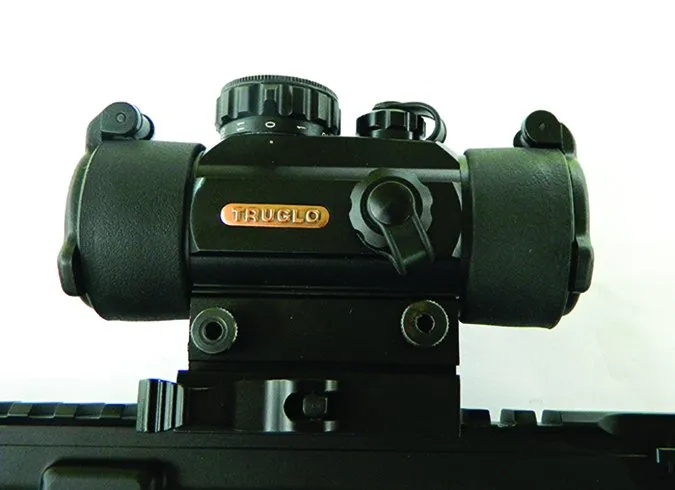
Our Team Said: Fans of the M1 30 Carbine among the raters were discouraged, or perhaps enlightened, by the practical comparison of ratings for ammo, magazines, and accessorizing. That is what we do, and the older platform’s limits are reality. But in practical handling, the M1 Carbine came into its own. The rifle is lighter than the AR-15 and somewhat easier to store. It takes up less space and is less likely to catch on furniture or be a problem in deployment from concealment. The safeties are each easily operated, with the lever-type safety of the M1 being fine for combat use. The AR-15 safety is a model of ergonomics and wins on that point. However, we like to keep defense rifles (and shotguns) at “home ready,” which in this case is ammo and magazine loaded in the rifle, but with the chamber empty and the safety set to Fire. Thus, to get the firearm into play, the home defender simply uses a gross motor skill and racks the action, and it’s ready. In making the rifles ready fast, the M1 is a clear winner. The AR-15 is easily racked, true, but the M1 Carbine is much easier and may be racked and made ready even from the firing position. The bolt is very smooth with a short throw. If you have to reload, magazine changes are much faster with the AR-15, but the M1 carbine isn’t slow by any means. In home defense you have to decide how many times you will miss, since you’re not limited to what you can carry, usually. Also, the AR-15 has an advantage in reliable capacity with 20- and 30-round magazines. The M1 Carbine magazines we tested had half the capacity of a standard AR 30-rounder. Press checks are easier with the M1 30 Carbine, but each rifle simply requires a different technique.
Home defense is about careful maneuvering and delivering a shot accurately. The 30 Carbine is light, fast handling, and moves like a good-quality 22-caliber rifle. But its shortcomings compared to the AR are simply to great to ignore. Would we consider someone with an M1 30 Carbine to be well armed to defend the home? Absolutely. Would we rather have an AR of some configuration? Absolutely.
PREVIOUS M1 CARBINE TESTS
Over the years, we’ve tested several M1 Carbines, and because of their timeless designs and ongoing interest by gun owners, the handy semi-auto is likely to keep going strong for generations. Here are a few past evaluations of the M1.
Inland Manufacturing M1 1945 Carbine 30 Carbine, $1079
GUN TESTS GRADE: A-
Auto-Ordnance M1 Carbine Paratrooper Model AOM150 30 Carbine, $941
GUN TESTS GRADE: A-
Auto-Ordnance AOM130 M1 Carbine 30 US Carbine, $899
GUN TESTS GRADE: B-
Fulton Armory Service Grade M1 Carbine 30 US Carbine, $1300
GUN TESTS GRADE: A
CMP-2 Inland Carbine 30 US Carbine, $495
GUN TESTS GRADE: A+
Written and photographed by Gun Tests Staff, using evaluations from Gun Tests team testers.






















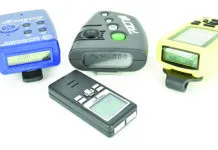











could you give me the top 10 AR rifles between $400 & $900 that are dependable in home defense in the 556nato & 762×39 caliber & are the “pups” better or equal & are they less expensive? thanks